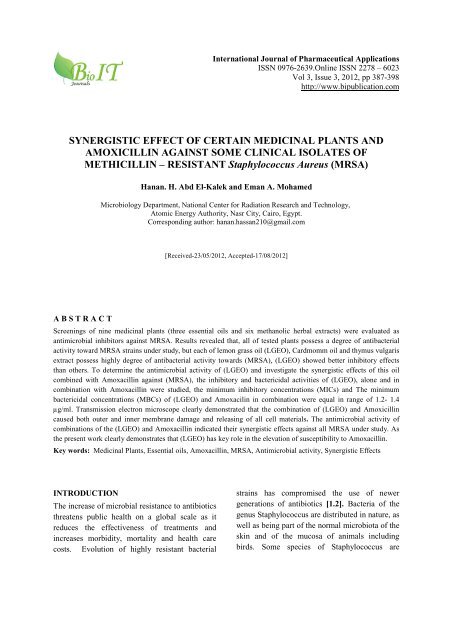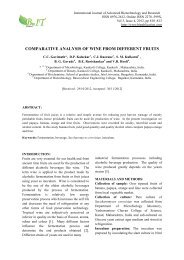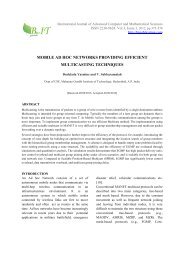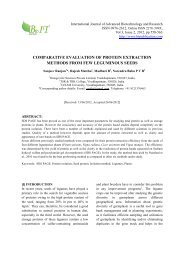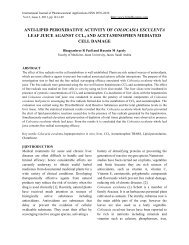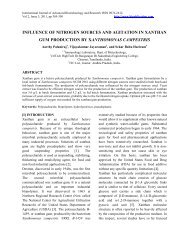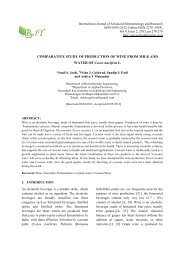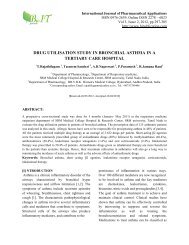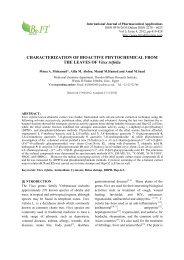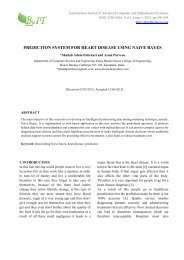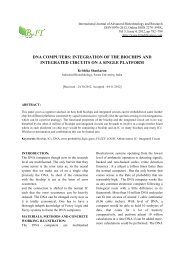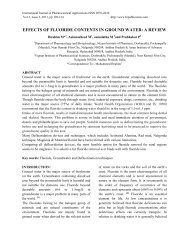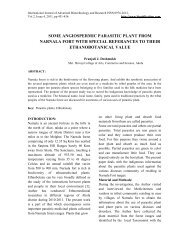SYNERGISTIC EFFECT OF CERTAIN MEDICINAL PLANTS AND ...
SYNERGISTIC EFFECT OF CERTAIN MEDICINAL PLANTS AND ...
SYNERGISTIC EFFECT OF CERTAIN MEDICINAL PLANTS AND ...
Create successful ePaper yourself
Turn your PDF publications into a flip-book with our unique Google optimized e-Paper software.
<strong>SYNERGISTIC</strong> <strong>EFFECT</strong> <strong>OF</strong> <strong>CERTAIN</strong> <strong>MEDICINAL</strong> <strong>PLANTS</strong> <strong>AND</strong> AMOXICILLIN AGAINST SOME CLINICAL ISOLATESfrom 4.25 µg/ml to 1.3 µg/ml in combination with1.25 µg/ml (equivalent to 1/14 MIC) of LGEO.The activity of Amoxacillin was enhanced 14-fold by combining with LGEO. Muroi et al. [35]reported that the activity of methicillin wasenhanced 32-fold by combining with anacardicacids against MRSA ATCC 33591.Table (6): Fractional inhibitory concentrations (FIC)values for the combination between Amoxicillin andLGEO.TestisolateFIC(Amoxicillin0.30 c a0.35 c aFIC(LGEO)FICIndexInteractionMRSA20.52 b b 0.82 a c SynergyMRSA160.56 b b 0.90 a c SynergyMRSA18 0.26 c a 0.60 b b 0.86 a c Synergy** Mean values followed by different superscript (withincolumns) and different subscripts (within rows) aresignificantly different at the 5 % levelIn this study the interpretations of activity ofLGEO combined with Amoxacillin produced asignificantly synergistic activity against the testedMRSA (M2, M16 and M18) (Table 6). Similarly,Betoni et al. [45] suggested that the lemongrassoil presented the highest synergism rate withantimicrobial drugs (penicillin, oxacillin,vancomycin, ampicillin, chloramphenicol,gentamicin, netilmicin, tetracycline,erythromycin, cotrimoxazole, and ofloxacin)against Staphylococcus aureus. The antibacterialactivity of the combinations of the ethanol extractof rosemary and cefuroxime showed synergisticeffects against all tested MRSA [26].Generally the data revealed that, LGEO hadsignificantly improved the inhibitory effects theAmoxacillin. This might indicate that the plantmaterial allowed better entrance of the drugthrough the outer layers to the cell wall, which isthe target site for this antibiotic. Variouscomponents of extracts can permeabilize the cellmembrane, increasing the penetration ofantibiotics. The interference with bacterialenzyme systems can also be a potentialmechanism of action [46]. These mechanisms ofaction can be obtained by the combination ofantibiotic with extract at a sub-inhibitoryconcentration applied directly to the culturemedium [17].Transmission electron micrographs:Transmission electron micrographs of MRSA(M2) untreated and treated with LGEO,Amoxacillin and in combination between themare presented in Fig 1. MRSA (M2) under study(without any treatment) had the typical structureof gram-positive and the cells showing an regularwall (Fig.1 A). Generally, after the bacterial cellswere exposed to the LGEO (2.5 µg/ml),Amoxacillin (4.25 µg/ml) and in combinationbetween them (1.4 µg/ml). With the treatment ofamoxicillin there was a little remarkable changein the cell morphology and cell content, but incase of LGEO and combination treatment therewas significantly shrunken and the cell size wasreduced. All treatments caused swelling of thecell wall and distribution of the cytoplasmicmembrane. In addition, cells were found to havedensely stained cell walls and irregularcytoplasmic membranes and induced emptyspaces in the cells (Fig 1 C and D).Fig. 1 C, D revealed that the LGEO affected thestructural organization of the cytoplasm morethan the cell wall of treated MRSA (M2). It mightbe proposed that in the primary phase, the testedoil probably bind the bacterial cell surface andpenetrate into the cell wall causing it to swellfollowed by cytoplasmic membrane damagewhile the cells shrink as a defense against thetested oil. LGEO is composed of severalchemical components. Its antibacterial activitymay have several targets of action on thebacterial cell. The sites of action for the LGcomponents would depend on the properties ofcompounds; some might act on separate targetsand some might be a consequence of anothermechanism. This study confirmed the mode ofantibacterial action of other essential oilscomponents which has been reviewed by Burt[10] that lipophilicity of the oil components playsan important role in penetrating the lipid layer ofthe bacterial cell membrane and mitochondriaHanan. H. Abd El-Kalek and Eman A. Mohamed 394
<strong>SYNERGISTIC</strong> <strong>EFFECT</strong> <strong>OF</strong> <strong>CERTAIN</strong> <strong>MEDICINAL</strong> <strong>PLANTS</strong> <strong>AND</strong> AMOXICILLIN AGAINST SOME CLINICAL ISOLATEScausing loss of structural organization andintegrity. The monoterpene alcohol, amongcomponents of LGEO may target membraneintegrity causing intracellular leakage. This mightbe due to the solvation of phospholipids of themembrane [47].CAFig. 1 Transmission electron micrographs of MRSA(M2) untreated cells (A) after exposure to Amoxacillin(B), LGEO (C) and in combination (D)This study confirmed the mode of antibacterialaction of LGEO has been reviewed by Aeimsaardet al., [12] that transmission electronmicrographs demonstrating morphologicalchanges of S. aureus DMST 4745 after exposureto various concentrations of lemongrass and itsmajors components showed respect to theleakage of cell constituents and the cell contentsin many bacteria were lost.CONCLUSIONBThis strategy is named ‘‘herbal shotgun’’ or‘‘Synergistic multi-target effects’’ and refers toDthe use of herbals and drugs in a multitargetedapproach of mono or multi-extract combinationsaffecting not only a single target, but several,cooperating in an agonistic synergistic way. Theapproach is not exclusive for extractcombinations, since effective combinationsbetween single natural products, essential oils orextracts with chemosynthetic or antibiotics havebeen described by [35,26]. Several reportsindicate different antibiotic combinations assyedin vitro and applied in the human and veterinaryclinics, but combinations of natural products andsynthetic drugs are not reported. The resultsobtained in this investigation suggest that Lemongrass essential oil could be a source ofmetabolites with antibacterial modifying activityto be used as adjuvants to antibiotic therapyagainst multidrug-resistant bacteria as the MRSAstrains.REFERENCES1. Levy S. B. (2002): The Antibiotic Paradox: How theMisuse of Antibiotics Destroys Their Curative Powers.Perseus Publishing, Cambridge, MA.2. Moghadam, S. M.; Maleki, S. Darabpour, E. Motamedi,H. Nejad, M. S. (2010): Antibacterial activity of eightIranian plants extracts against methicillin and cefiximeresistant Staphylococcus aureus strains. Asian pacific J.of tropical medicine 262-265.3. Zuo G.Y.; Wanga G.C.; Zhaoa Y.B.; Xua G.L. ; HaobX.Y.; Hanc J.; Zhaoc Q. (2008): Screening of Chinesemedicinal plants for inhibition against clinical isolate ofmethicillin-resistant Staphylococcus aureus (MRSA)J.of Ethnopharmacology 120, 287–290.4. Nwankwo EOK, Abdulhadi, Sale, Magagi, A. andIhesiulor Gabriel. (2010): Methicillin resistant S. aureus(MRSA) and their antibiotic sensitivity pattern in KanoNIGERIA. AFR. J. CLN. EXPER. Microbio1 1, (1):129-136.5. Alzohairy M. A. (2011): Colonization and antibioticsusceptibility pattern of methicillin resistanceStaphylococcus aureus (MRSA) among farm animals inSaudi Arabia. J. of Bacteriology Research 3, (4): 63-68.Hanan. H. Abd El-Kalek and Eman A. Mohamed 395
<strong>SYNERGISTIC</strong> <strong>EFFECT</strong> <strong>OF</strong> <strong>CERTAIN</strong> <strong>MEDICINAL</strong> <strong>PLANTS</strong> <strong>AND</strong> AMOXICILLIN AGAINST SOME CLINICAL ISOLATES6. Enright, M.C. (2003): The evolution of a resistantpathogen the case of MRSA. Current Opinion inPharmacolo. 3, 474–479.7. Saiful A. J.; Mastura M.; Zarizal S.; Mazurah M. I.;Shuhaimi M.; Ali A. M (2006): Detection ofmethicillin-resistant Staphylococcus aureus usingmecA/nuc genes and antibiotic susceptibility profile ofMalaysian clinical isolates. World J. MicrobiolBiotechnol 22, 1289–1294.8. George A. Pesewua, Ronald R. Cutler, David P.Humber (2008): Antibacterial activity of plants used intraditional medicines of Ghana with particular referenceto MRSA. J. of Ethnopharmacology 116, 102–111.9. Matias E. F.F. ; Santos,K. K.A. ; Almeida T. S. ; CostaJ. G. H. ; Coutinho H. D. M. (2011): Phytochemicalscreening and modulation of antibiotic activity byOcimum gratissimum L. Biomedicine & preventiveNutrition 1, 57- 60.10. Burt S. (2004): Essential oils: their antibacterialproperties and potential applications in foods – areview. International Journal of Food Microbiology 94,223–253.11. Khunkitti W. (2010): Chapter 6 In vitro antimicrobialand antioxidant activities of some Cymbopogonspecies. In: Akhila, A. (Ed.) Essential Oil-BearingGrasses CRC Press, London, pp. 167–183.12. Aiemsaard J.; Aiumlamai, S.; Aromde, C.; Suwimol T.and Khunkitti W (2011): The effect of lemongrass oiland its major components on clinical isolate mastitispathogens and their mechanisms of action onStaphylococcus aureus DMST 4745. J. Vet. Sci., 10, 1-7.13. Hammer K.A.; Carson C.F.; Riley; T.V. (1999):Antimicrobial activity of essential oils and other plantextracts. J. of Applied Microbiology 86, 985–990.14. Tohidpour A.; Sattari M.; Omidbaigi R.; Yadegar A.;Nazemi J. (2010): Antibacterial effect of essential oilsfrom two medicinal plants against Methicillin- resistantStaphylococcus aurues (MRSA). Phytomedicine 17,142-145.15. Aqil F.; Ahmad I. and Owais M. (2006): Evaluationof anti-methicillin-resistant Staphylococcus aureus(MRSA) activity and synergy of some bioactive plantextracts J. Biotechnolo. 1, 1093–1102.16. Cos P.; Vlietinck A. J.; Vanden Berghe D. and Maes L.(2006): Anti-infective potential of natural products:how to develop a stronger in vitro ‘proof-of concept. JEthnopharmacol.106, 290–302.17. Coutinho HDM. ; Costa JGM. ; Lima EO. ; Falca˜o-Silva VS. ; Siqueira Jr,JP (2009):- .Herbal therapyassociated with antibiotic therapy potentiation of theantibiotic activity against methicillin-resistantStaphylococcus aureus by Turnera ulmifolia L. BMCComplement Altern Med; 9:13. [2].18. Habsah M.; Amran M.; Mackeen M. M.; Lajis N. H.;Kikuzaki H.; Nakatani, N.; Rahman A. A.; Ali A. M.(2000): Screening of Zingiberaceae extracts forantimicrobial and antioxidant activities. J. ofEnthnopharmacology 72, 403-410.19. Senthilkumar A.; Kannathasan K. and Venkatesalu V.(2009): Antibacterial activity of the leaf essential oil ofBlumea mollis (D.Don) Merr. World J. MicrobialBiotechnol, 25, 1297- 1300.20. Finegold S.M. and Baron F.A. (1996): Baily and Scottsdiagnostic Microbiology.8th ed. Piohnilaald SaundersCo. functional antioxidants, antiradicals andantimicrobials in foods. J. Food Chem. 91, 621–632.21. Meena M. R. and Sethi V. (1994): Antimicrobialactivity of essential oils from spices. J. of food Scienceand technology, 31, 68-70.22. Rota C.; Carraminana J.J.; Burillo J. and Herrera A.(2004): In vitro antimicrobial activity of essential oilsfrom aromatic plants against selected food bornepathogen. J. of food protection. 67, 1252-1256.23. Amsterdam D. (1996): Susceptibility testing ofantimicrobials in liquid media. In: Loman, V. (Ed).Antibiotics in laboratory medicine. William andWillkines,baltimore, MD, 52-111.24. Mandal S.; Mandal MD. and Pal NK. (2004):Evaluation of combination effect of ciprofloxacin andcefazolin against Salmonella enterica serovar typhiisolates by in vitro methods. Calicut Med. J.; 2 (2):e2.25. Pei R. S.; Zhou F.; Ji B. P. and Xu J. (2009):Evaluation of combined antibacterial effects of eugenol.Hanan. H. Abd El-Kalek and Eman A. Mohamed 396
<strong>SYNERGISTIC</strong> <strong>EFFECT</strong> <strong>OF</strong> <strong>CERTAIN</strong> <strong>MEDICINAL</strong> <strong>PLANTS</strong> <strong>AND</strong> AMOXICILLIN AGAINST SOME CLINICAL ISOLATEScnnamaldehyde, thymol, carvacrol against E.coli withan improved method. J. of Food science 74, M379-M383.26. Jarrar N.; Abu-Hijleh A. and Adwan K. (2010):Antibacterial activity of Rosmarinus officinalis L. aloneand in combination with cefuroxime againstmethicillin- resistant Staphylococcus aureus. AsianPacific J. of Tropical Medicine 121-123.27. Elaine E. Huter (1984): Practical Electron microscopy.A Beginner ’ s illustrated Guide.28. Rao, M. and Blane, K. (1985): PC-STAT, statisticalprograms for microcomputers Ver. 1A. Food ScienceDepartment, University of Georgia, Athens, GA, USA.29. Coutinho H. D. M.; Costa J. G. M.; Siqueira J. P.(2008a): In vitro anti-Staphylococcal activity of hyptismartiusii Benth aginast methicillin- resistantStaphylococcus aureus MRSA strains. Rev. BrasFarmacogn 18 (suppl.):670-5.30. Coutinho H. D. M.; Costa J. G. M. ; Lima E. O. ;Falcao-Silva V. S.; Siqueira Jr JP. (2008b):-Enhancement of antibiotic activity against a multiresistant Escherichia coli by Mentha arvensis L. andchlorpromazine. Chemotherapy 54,328-30.31. Aburjai T.; Darwish, R; Al-Khalil S.; Mahafzah A. andAl-Abbadi, A (2001): Screening of antibiotic resistantinhibitors from local plant materials against twodifferent strains of Pseudomonas aeruginosa. J.Ethnopharmacology 76, 39–44.32. Saccetti G.; Majetti S.; Muzzoli M.; Scaglianti M.;Manfredini S.; Radice M. and Bruni R. (2005):Comparative evaluation of 11 essential oils of differentorigin as functional antioxidants, antiradicals andantimicrobials in foods, Food Chemistry 91 (2005)621–63233. Lertsatitthanakorn P.; Taweechaisupapong S.; AromdeeC. and Khunkitti W. (2006): In vitro bioactivities ofessential oils used for acne control. J. Int ofAromatherapy. 16, 43–49.34. Darwish R.; Aburjai T.; Al-Khalil S. and Mahafzah A.(2002): Screening of antibiotic resistant inhibitors fromlocal plant materials against two different strains ofStaphylococcus aureus. J. Ethnopharmacology. 79,359–364.35. Muroi H.; Nihei K.; Tsujimoto K. and Kubo I. (2004):Synergistic effects of anacardic acids and Methicillinagainst resistance Staphylococcus aureus J.Bioorganicand Medicinal Chemistry. 12, 583-587.36. Rodriguesa F.; Costaa J. and Coutinho, H. (2009):Synergy effects of the antibiotic gentamicin and theessential oil of Croton zehntneri. J. Phytomedicine. 16,1052–1055.37. Palaniappan K. and Holley R. (2010): Use of naturalantimicrobials to increase antibiotic susceptibility ofdrug resistant bacteria Int. J.Food Microbiolo. 140,164–168.38. Coutinho H. D. M. ; Costa J. G.M. ; Falcao-Silva V. S.; Siqueira-Junior J. P.; Lima E. O. (2010): Effect ofMomordica charantia L. in the resistance toaminoglycosides in methicillin – resistantStaphylococcus aureus. Comparative Immunology,Microbiology and infectious Diseases.39. Garvey M.I.; Rahmanb, M. M.; Gibbonsb S. andPiddocka J.V. (2011): Medicinal plant extracts withefflux inhibitory activity against Gram-negativebacteria Int. J. Antimicrobial Agents. 37, 145–151.40. Juve J.; Kanner J.; Schved F. and Weisslowicz H.(1994): Factors that interact with antimicrobial actionof thyme essential oil and its active constituents. J.Appl Bacteriol. 76, 626–631.41. Kristianse J.E. and Amaral L. (1997): The potentialmanagement of resistant infections with non-antibiotics.J. Antimicrob. Chemother. 40, 319–27.42. Helander I. M.; Alakomi H. L.; Latva-kala K.;Sandholm M. T.; Pol I.; Smid E. J.; Gorris L.G.M. andVon Wright A. (1998): Characterization of the action ofselected essential oil components on Gram-negativebacteria. J. Agric. Food Chem 46, 3590 –3595.43. Nicolson K.; Evans G. and Toole, P.W. (1999):Potentiation of methicillin activity against methicillinresistantStaphylococcus aureus by diterpenes. FEMSMicrobiol Lett.179, 233–239.44. Choi J. ; Kang O. ; Brice O. ; Lee Y. ; Chae h. ; OhY. ; Sohn D. ; Park H. ; Choi H. ; Kim S. ; Shin D.Hanan. H. Abd El-Kalek and Eman A. Mohamed 397
<strong>SYNERGISTIC</strong> <strong>EFFECT</strong> <strong>OF</strong> <strong>CERTAIN</strong> <strong>MEDICINAL</strong> <strong>PLANTS</strong> <strong>AND</strong> AMOXICILLIN AGAINST SOME CLINICAL ISOLATESand Kwon Y. (2010): Antibacterial activity of eckloniacava against Methicillin-Resistant Staphylococcusaureus and Salmnella spp. J. Food Borne and Disease.,7, (4): 4355-441.45. Betoni J.E.C.; Mantovani R.P.; Barbosa LN. ; StasiL.C.D. and Junior AF (2006): Synergism between plantextract and antimicrobial drugs used on Staphylococcusaureus diseases. Mem Inst Osualdo Cruz. 10, (4): 387-390.46. Wendakoon C and Sakaguchi M. (1995): Inhibition ofacid decarboxylase activity of Enterobacter aerogenesby active components in spices. J. Food Prot.58, 280–283.47. Denyer S. P. (1995): Mechanisms of action ofantibacterial biocides. International Bio deterioration &Biodegradation 36, 227–245.Hanan. H. Abd El-Kalek and Eman A. Mohamed 398


